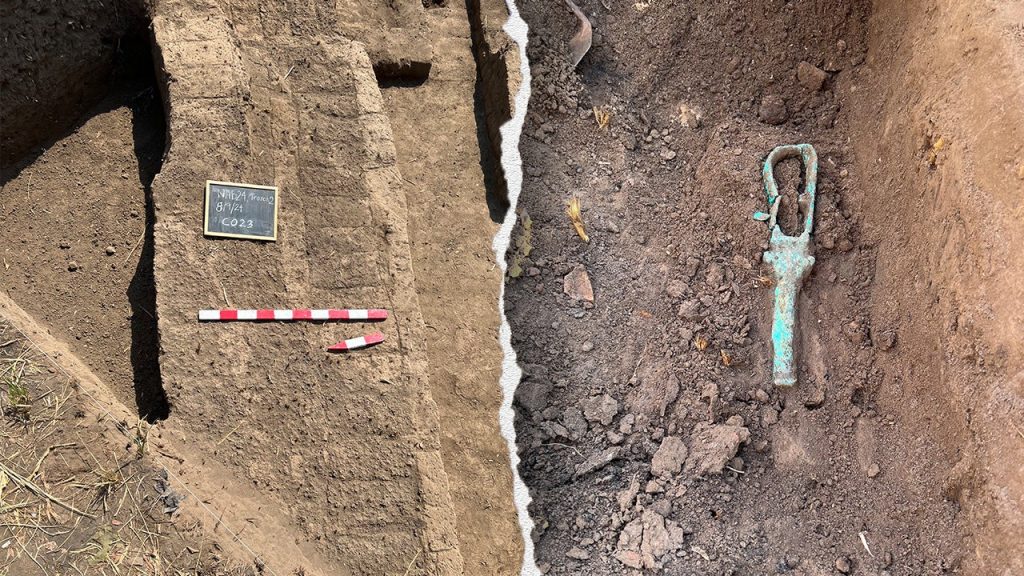Archaeologists have made a significant discovery in the Nile Delta, unveiling multistory buildings from the lost city of Imet, also known as Buto. This excavation, conducted by British specialists in collaboration with experts from the University of Sadat City in Cairo, sheds new light on urban life during antiquity. The findings were announced by the University of Manchester on June 24, marking a pivotal moment in the understanding of this ancient Egyptian city.
| Article Subheadings |
|---|
| 1) Discovery of Multistory Structures |
| 2) Technological Innovations in Archaeology |
| 3) Insights into Urban Infrastructure |
| 4) Artifacts and Cultural Context |
| 5) Broader Implications of the Findings |
Discovery of Multistory Structures
Recent excavations at Tell el-Fara’in in the Nile Delta have revealed the remarkable structures of Imet, an ancient city that had previously slipped into obscurity. The discovery, announced by the University of Manchester, comes as a culmination of efforts over several decades, with the latest excavations conducted by a team of British archaeologists alongside Egyptian specialists. It specifically highlighted the existence of multistory buildings supported by notably thick foundation walls, suggesting they were designed to support a growing urban population. These tower houses, which were likely utilized during the Ptolemaic Period (332 B.C. to 30 B.C.), are relatively rare finds in Egypt, primarily clustered within this region.
Technological Innovations in Archaeology
The success of this excavation stems partly from advancements in technology. Remote sensing and satellite imagery technology played a pivotal role in identifying areas rich in “ancient mudbricks” before any physical excavation occurred. This method led researchers to pinpoint clusters of architectural remains that went unnoticed during prior excavations. The use of such innovative approaches marks a significant shift in archaeological methods, allowing for a more efficient and thorough exploration of sites that may hold untold historical significance. By embracing high-tech methodologies, the archaeologists were better equipped to uncover the layers of history within the Nile Delta.
Insights into Urban Infrastructure
The findings at Imet have crucial implications for understanding the urban layout and infrastructure of ancient Egyptian cities. According to Nicky Nielsen, a lecturer from the University of Manchester, these tower houses were primarily found in the Nile Delta area, dating back to a time when urban growth was rapidly transforming the landscape. The density of the architecture indicates that Imet served as a vibrant city, complete with its own complex urban infrastructure. Buildings for storing grain, granaries, and even ceremonial roads linked to ancient religious practices were discovered, vividly illustrating the daily lives of its inhabitants and their connection to both the economy and spirituality of ancient Egypt.
Artifacts and Cultural Context
In addition to the architectural remnants, archaeologists have unearthed several artifacts that provide insight into the daily lives and religious customs of the people who inhabited Imet. Among the finds are an ushabti, a small funerary figurine, and a bronze sistrum—a musical instrument associated with the goddess Hathor. Remarkably, a limestone plaster floor was also identified within one of the large buildings, constructed across a processional road that once led to the temple of Wadjet, the city’s patron deity. The presence of such artifacts speaks volumes about the artistic and spiritual inclinations of the society that flourished in this now-lost city.
Broader Implications of the Findings
The implications of this discovery extend beyond the mere architectural and material culture. Imet is emerging as a crucial site that could revolutionize how scholars understand the Late Period of Egyptian history. This rediscovery not only highlights the vibrant urban life of ancient Egyptians but also offers an opportunity to rethink aspects such as urban planning, economic practices, and religious transitions. As noted in the university’s communications, the excavation opens new doors to understanding the intertwining of daily life, spirituality, and the economic fabric of the Nile Delta during a pivotal period. Such insights are invaluable for historians and archaeologists alike, fostering a deeper appreciation for the complexities of ancient civilizations.
| No. | Key Points |
|---|---|
| 1 | Archaeologists have uncovered multistory buildings in the ancient city of Imet, located in the Nile Delta. |
| 2 | Advanced technologies like remote sensing played a key role in the discovery process. |
| 3 | The findings reveal a densely populated urban environment with complex infrastructure. |
| 4 | Numerous artifacts have been found, including a funerary figurine and a ceremonial road linked to religious practices. |
| 5 | The excavation helps reframe historical narratives regarding the urban and social dynamics of Late Period Egypt. |
Summary
The excavation at Tell el-Fara’in has opened new avenues for understanding the urban life of ancient Egypt. The discovery of multistory buildings, alongside a variety of artifacts, provides crucial insights into the architectural innovations, economic structures, and religious practices of the time. This find positions Imet as a significant center of study for historians and archaeologists, promising to reshape narratives about the complexities and vibrancy of life during the Ptolemaic Period.
Frequently Asked Questions
Question: What new technology was used in the excavation?
Archaeologists employed remote sensing and satellite imagery technology to identify potential sites for excavation, which proved effective in locating hidden architectural remains.
Question: What was Imet known for in ancient times?
Imet, also referred to as Buto, was known as a vibrant urban center with a complex infrastructure during the Ptolemaic Period, housing significant architectural structures and cultural artifacts.
Question: Why is this discovery significant to our understanding of ancient Egypt?
The excavation of Imet provides new insights into urban planning, daily life, and religious practices in ancient Egypt, helping scholars re-evaluate the complexities of its civilization.


